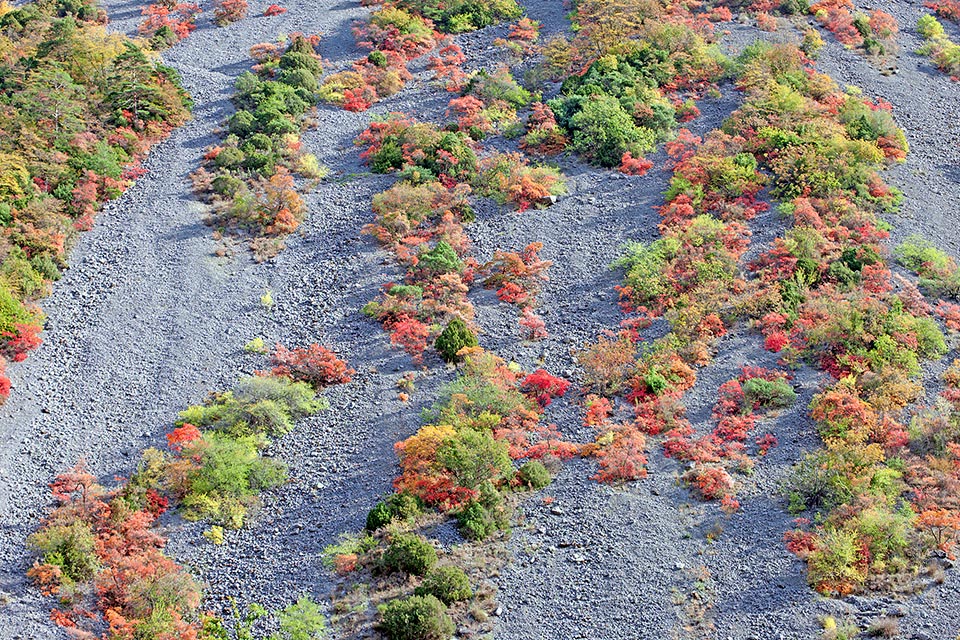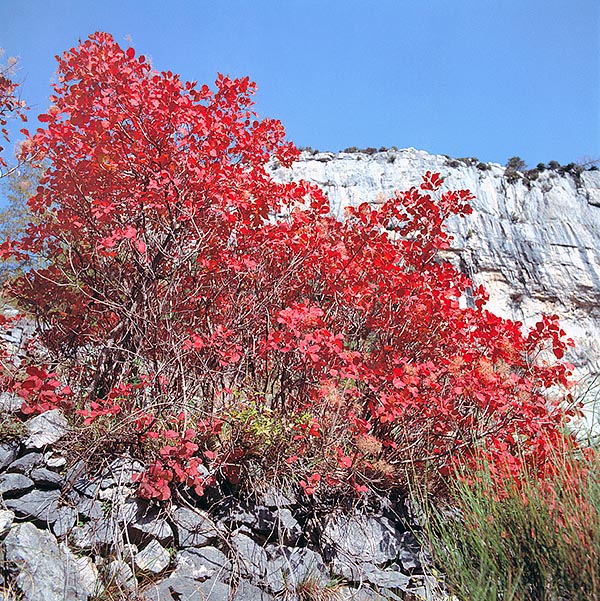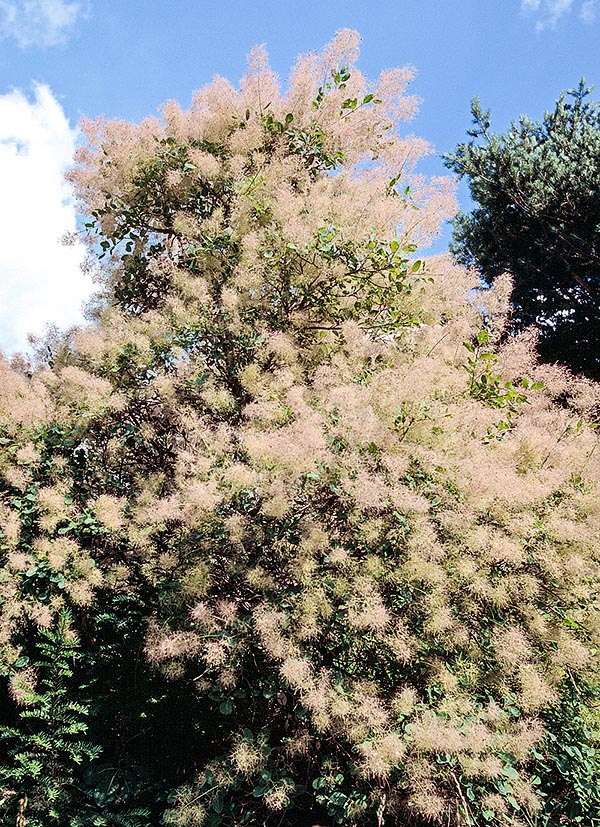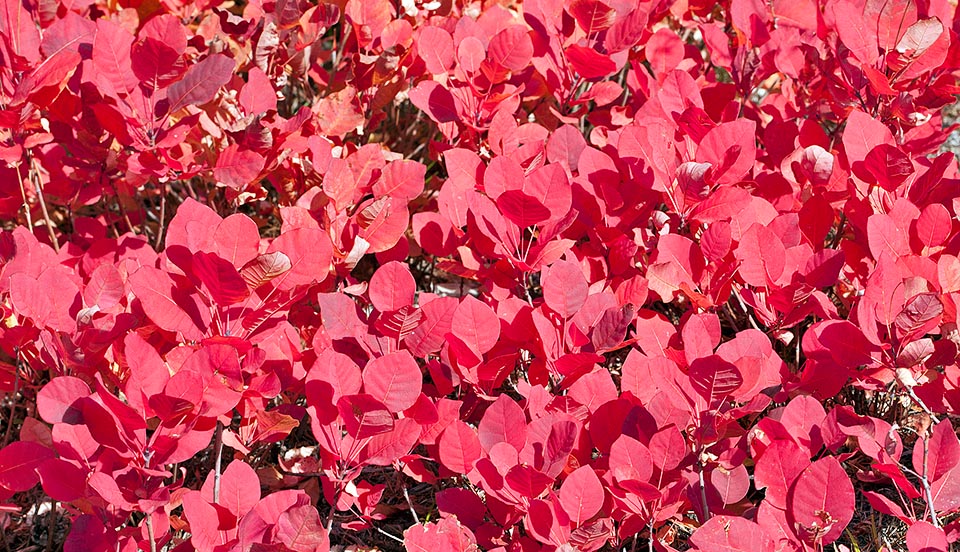Family : Anacardiaceae

Text © Dr Barbara Barisani

English translation by Mario Beltramini

Native to the Mediterranean region up to central-west Asia, the Cotinus coggygria is a 0,5-3 m bush or small tree. Even if can be found in the woods, it loves dry sites, neutral or basic soils and colonizes the screes up to about 800 m of altitude. It’s suddenly noted in autumn, when the leaves have fiery colours © Giuseppe Mazza
The genus Cotinus includes some species of trees or deciduous shrubs growing in the environments with temperate climate of the boreal hemisphere (Mediterranean region, China, southern USA). They are cultivated due to the showy panicle infructescences that ripen by late summer and to the leaves, that in autumn get intense colourations.
The Cotinus coggygria Scop. (1771) is a shrub or small tree 0,5-3 m tall. It is diffused from the Mediterranean region to central-western Asia.

Wonderful sight among rocks. Nowadays Cotinus coggygria has become also a garden plant © G. Mazza
The name of the genus is the Latin one “cotinus” or “cotanus” given by Pliny to an Apennine shrub from which they got a purplish dye. In Greek, the term “κότινος” was referring to the wild olive tree.
The etymology of the specific name comes from the Greek term reported by Theophrastus, “κοκκυγέα”, in Latin “coccygéa”, that in Italian means “cotino, scotano, sommacco”. Probably the specific term may be also related to the Latin “coccum”, cochineal, due to the bright red colour the leaves assume in autumn.
Common names: Cotino, Albero della nebbia, Sommacco selvatico, Scotano, Capecchio (Italian), Fustet, Arbre à perruque (French), Perückenstrauch (German), Árbol de las pelucas (Spanish), Smoke Tree, Wig Tree (English).
The leaves are entire, oboval, obtuse, glabrous, of pale green colour. They are up to 8 cm long and in autumn they become of yellow, orange, red colour.
The small yellowish flowers (3-5 mm) form and ample thinned and ramified panicle, facing upwards, 10-25 cm long, the pedicels bear many flowers that when ripe elongate generating a light and showy feathery infructescence. The hairs assume gradually the violet green, then get reddish, finally brown grey colours.
It is in bloom from May to July, whilst it fructifies from August to October. It grows in the continental and Mediterranean climates, on neutral or basic soils, up to 800 m of altitude. It prefers dry environments such as bushes, hedges, calcareous rocks, arid coasts, thickets, stony places, but it can be found also in the woods, close to banks and sources and in the nitrophilous vegetation of natural or anthropic origin.
It is cultivated as ornamental plant in parks and gardens, from where it can naturalize and spread spontaneously. It is utilized as isolated specimen, also in groups, to form shrubby borders or thickets that valorize the effect “smoke” given by the showy plumes.

In spring it surprises even more with gauzy inflorescences that have earned it the fame of misty tree © Giuseppe Mazza
They are hardy plants that are to be cultivated in a soil of average fertility, well drained and sunny. The exposition in full sun, the poor and dry soil and the appropriate prunings favour the intensity of the autumnal colouration of the leaves. It propagates by autumnal sowings, or by layering and offshoot in early spring, or, also, by placing to root herbaceous or semi-woody cuttings in summer.
Once, collected and pulverized, was utilized in hide tanning.
Several varieties of smoke tree do exist, they differentiate for the colour of the leaves and of the flowers. Here are some of them:
• Cotinus coggygria ‘Notcutt’s Variety’ – Shrub of globose shape that reaches the 4 m of height. It produces leaves of wine red colour in summer and bright red in autumn and purple pink plumes.
• Cotinus coggygria ‘Flame’ – Small tree or vigorous shrub, up to 6 m tall, producing oval leaves up to 10 cm long, green in summer and orange red in autumn. The plumes are of intense pink colour.
• Cotinus coggygria ‘Royal Purple’ – Produces dark purple red leaves in summer and scarlet red in autumn. The plumes are pink.
• Cotinus coggygria ‘Grace’ – Small tree or vigorous shrub, up to 6 m tall, producing up to 10 cm long oval leaves, purple in summer and bright red in autumn. The plumes are purple pink.
A similar species belonging to the genus Cotinus is the Cotinus obovatus Raf. (1840), known also as Cotinus americanus Nutt (1846), Cotinus cotinoides (Nutt. ex Chapm.) Britton (1894), Cotinus retusus Raf. (1840), Rhus cotinoides Nutt. ex Chapm. (1860). It is a small tree or a shrub shaped like an ample cone, up to 10 m tall, present in the south-eastern USA. The leaves are obovate, up to 12 cm long, of orange-translucent pink colour in spring. In autumn they become bright orange and purple red. The plumes, up to 30 cm long, are pinkish grey and are present from summer to late autumn.
Synonyms: Cotinus coccygia Fournier, Cotinus arenarius F. A. Barkley (1950), Cotinus cinereus (Engl.) F. A. Barkley (1950), Cotinus coriarius Duhamel (1755), Cotinus cotinus (L.) Sarg. (1891), Cotinus ellipticus Raf. (1840), Cotinus velutinus (Engl.) F. A. Barkley (1950), Rhus cotinus L. (1753), Rhus laevis Wall. ex G. Don (1832), Rhus velutina Wall. ex G. Don (1832).

Horticultural varieties exist with more or less red leaves also in summer and spring plumes intense pink or purple. It has become an easy plant for all seasons © G. Mazza
→ To appreciate the biodiversity within the ANACARDIACEAE family please click here.
